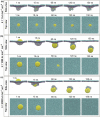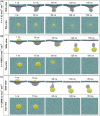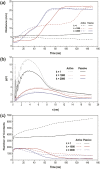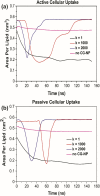Molecular dynamics simulation insights into the cellular uptake of elastic nanoparticles through human pulmonary surfactant
- PMID: 36128539
- PMCID: PMC9403708
- DOI: 10.1039/d2ra03670c
Molecular dynamics simulation insights into the cellular uptake of elastic nanoparticles through human pulmonary surfactant
Abstract
The interaction between inhaled nanoparticles (NPs) and the pulmonary surfactant (PS) monolayer has drawn significant attention due to its potential in drug delivery design and application for respiratory therapeutics in active and passive cellular uptake pathways. Even though much attention has been given to explore the interaction between NPs and the PS monolayer, the effects of the NP elasticity on the translocation across the PS monolayer have not been thoroughly studied. Here, we performed a series of coarse-grained (CG) molecular dynamics simulations to study active or passive cellular uptake pathways of three NPs with different elasticities through a PS monolayer. The differences between active and passive pathways underly the enhanced targeting ability by ligand-receptor interaction (L-R interaction). In the active or passive cellular uptake pathways, it is found that the increase in stiffness level leads to a higher penetrability of NPs at the same time range. The soft NP has always been withheld inside the PS monolayer due to the lowest level of elasticity, while the other two types of NPs penetrate through the PS monolayer as the simulation progresses toward the end. The NPs in the active cellular uptake pathways take a longer time to penetrate the PS monolayer, resulting in a longer average penetration distance of approximately 40.55% and a higher average number of contacts, approximately 36.11%, than passive cellular uptake pathways, due to the L-R interaction. Moreover, it demonstrates that NPs in active cellular uptake pathways have a significantly higher targeting ability with the PS monolayer. We conclude that the level of NP elasticities has a substantial link to the penetrability in active or passive cellular uptake pathways. These results provide valuable insights into drug delivery and nanoprobe design for inhaled NPs within the lungs.
This journal is © The Royal Society of Chemistry.
Conflict of interest statement
There are no conflicts of interest to declare.
Figures






Similar articles
-
A Simulation Study on the Interaction Between Pollutant Nanoparticles and the Pulmonary Surfactant Monolayer.Int J Mol Sci. 2019 Jul 4;20(13):3281. doi: 10.3390/ijms20133281. Int J Mol Sci. 2019. PMID: 31277358 Free PMC article.
-
A Review on Investigating the Interactions between Nanoparticles and the Pulmonary Surfactant Monolayer with Coarse-Grained Molecular Dynamics Method.Langmuir. 2024 Jun 11;40(23):11829-11842. doi: 10.1021/acs.langmuir.4c00909. Epub 2024 May 29. Langmuir. 2024. PMID: 38809819 Review.
-
Penetration of nanoparticles across a lipid bilayer: effects of particle stiffness and surface hydrophobicity.Nanoscale. 2019 Mar 7;11(9):4025-4034. doi: 10.1039/c8nr09381d. Epub 2019 Feb 15. Nanoscale. 2019. PMID: 30768108
-
Understanding receptor-mediated endocytosis of elastic nanoparticles through coarse grained molecular dynamic simulation.Phys Chem Chem Phys. 2018 Jun 20;20(24):16372-16385. doi: 10.1039/c7cp08644j. Phys Chem Chem Phys. 2018. PMID: 29445792
-
New views on cellular uptake and trafficking of manufactured nanoparticles.J R Soc Interface. 2013 Feb 20;10(82):20120939. doi: 10.1098/rsif.2012.0939. Print 2013 May 6. J R Soc Interface. 2013. PMID: 23427093 Free PMC article. Review.
Cited by
-
Elasticity-Driven Nanomechanical Interaction to Improve the Targeting Ability of Lipid Nanoparticles in the Malignant Tumor Microenvironment.Adv Sci (Weinh). 2025 Jul;12(26):e2502073. doi: 10.1002/advs.202502073. Epub 2025 Mar 27. Adv Sci (Weinh). 2025. PMID: 40145669 Free PMC article.
-
Elucidating anticancer drugs release from UiO-66 as a carrier through the computational approaches.RSC Adv. 2023 Nov 1;13(45):31897-31907. doi: 10.1039/d3ra05587f. eCollection 2023 Oct 26. RSC Adv. 2023. PMID: 37920197 Free PMC article.
References
LinkOut - more resources
Full Text Sources
Miscellaneous

